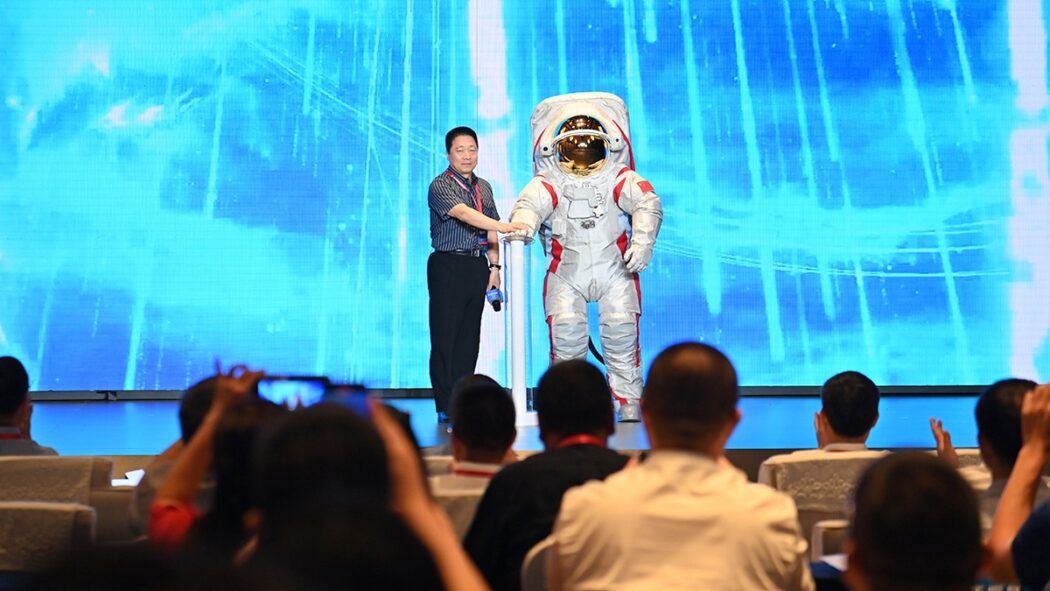China has officially introduced its new generation of space suits, which will be worn by its taikonauts during the upcoming lunar mission. The China Manned Space Agency (CMSA) showcased these advanced suits over the weekend, highlighting their importance in the country’s ambitious objective to launch its first crewed lunar mission by 2030, as reported by CNN.
The newly designed suits, featuring a striking red and white color scheme, are engineered to protect astronauts from the harsh conditions they will encounter on the lunar surface. They are equipped to handle extreme temperatures, safeguard against debris particles, and shield the wearer from harmful ultraviolet radiation. With a streamlined design for enhanced mobility, these suits include built-in long and short-range cameras, a control console, and an anti-reflective helmet visor designed to minimize the sun’s glare. Aesthetically, the suits draw inspiration from traditional Chinese armor: the upper part is adorned with stripes reminiscent of the silk ribbons worn by the Flying Apsaras depicted in ancient Dunhuang frescoes, while the lower portion features designs that evoke the flames of rocket launches.
Wu Zhiqiang, the deputy chief designer of astronaut systems at the China Astronaut Research and Training Center, elaborated on the challenges taikonauts will face on the lunar surface. He noted to CCTV that, “Unlike low-Earth orbit missions, astronauts will be in a harsh natural lunar environment during lunar extravehicular activities.” Wu emphasized that various environmental factors, including high vacuum and low gravity conditions, lunar dust and soil, complex terrain, temperature extremes, and strong radiation, will significantly impact both the astronauts’ work and their safety.

Earlier this year, in February, the CMSA announced the names of the spacecraft that will transport Chinese astronauts to the moon. The crewed spaceship has been designated as Mengzhou, which translates to “Dream Vessel” in English. The lunar lander will be called Lanyue, meaning “Embracing the Moon,” a name inspired by a poem written by Chairman Mao Zedong in 1965. If this mission proves successful, China will become the second nation in history to send astronauts to the moon, following the United States. Furthermore, China has plans to establish a research base near the lunar south pole by 2040. The China National Space Administration (CNSA) has already achieved significant milestones, including the successful completion of its first mission to collect rock and soil samples from the far side of the moon and return them to Earth.
In comparison, NASA revealed its own suits for the upcoming Artemis III mission to the moon in March of the previous year. This latest prototype, developed in collaboration with Axiom Space based in Houston, will be utilized during the Artemis program’s first crewed lunar landing since the Apollo 17 mission. The month-long Artemis III mission, which has experienced several delays, is currently aiming for a launch date in September 2026. Similarly, SpaceX has also made strides in the space suit realm, showcasing a sleek new design for astronauts during its successful Polaris Dawn mission.
The advancements in space suit technology reflect the growing interest and investment in lunar exploration, both by China and by other space-faring nations. As the space race intensifies, innovations like those seen in China’s new suits demonstrate a commitment to not only meet the challenges posed by extraterrestrial environments but also to ensure the safety and efficiency of astronauts on these ambitious missions.
With these developments, the world is closely watching China’s efforts as it seeks to establish a foothold in lunar exploration. The unveiling of the new space suits is just one aspect of a broader initiative that includes ambitious timelines and technological innovations designed to advance human presence on the moon and potentially beyond.
As various space agencies prepare for their lunar missions, including both crewed and robotic endeavors, the international community is on the brink of a new era in space exploration. China’s plans to establish a research base on the moon further highlight the strategic importance of lunar exploration, potentially paving the way for future missions that could involve international collaboration or competition.
In summary, the unveiling of China’s next-generation space suits is a significant step toward its goal of a crewed lunar mission by 2030. With features designed for extreme lunar conditions and a nod to cultural heritage, these suits symbolize the fusion of technology and tradition in China’s ambitious space program. As the country prepares for its historic mission, the global landscape of space exploration continues to evolve, with exciting prospects on the horizon for all involved.



